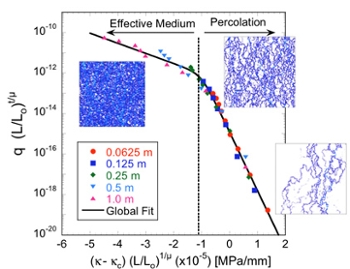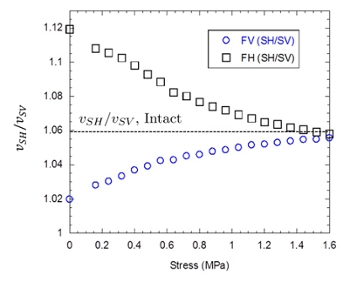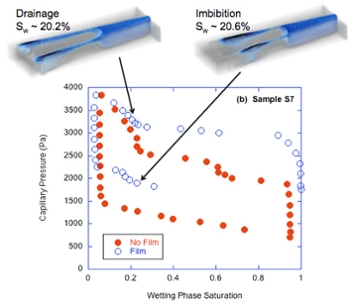Experimental and Digital Rock Physics
Our research encompasses: imaging and characterizing the effects of fractures & pores on deformation, fluid flow, and seismic wave propagation; effects of interaction between fluids and solids on material properties; scale and size effects of material properties; multiphase flow through fractured rock; underground structures and sediments.
Universal Scaling of Fracture Flow – Stiffness Relationship
Universal flow-stiffness function showing a full data collapse. The solid line is provided to guide the eye. The break in slope divides the effective medium regime from the percolation regime.
Finite-size scaling analysis applied to single fractures with weakly correlated aperture distributions reveals a fundamental scaling relationship between fracture stiffness and fracture fluid flow. Computer simulations extract the dynamic transport exponent, which is required to collapse the flow-stiffness relationships onto a universal scaling function. Near the critical percolation threshold, the scaling function displays two exponentially decaying regions whose transition point is governed by the multifractal spectrum of stressed flow paths. The resulting hydromechanical scaling function provides a link between fluid flow and the seismic response of a fracture.
Delineating Competing Mechanisms of Seismic Anisotropy: Fracutres vs. the Matrix
Measured interface wave velocities relative to the matrix velocity as a function of stress for samples: FH – fracture horizontal to the layering, FV – fractures parallel to the layering and an intact sample with no fractures. Isotropic condition: VSH/VSV ~ 1.
The seismic detection of fractures in an anisotropic medium is complicated by discrete modes that are guided or confined by fractures such as fracture interface waves. Fracture interface waves are generalized coupled-Rayleigh waves whose existence and velocity in isotropic media depend on the stiffness of the fracture, frequency of the source and shear wave polarization.
The question arises whether competing sources of anisotropy can be delineated for an anisotropic medium containing fractures. Our results demonstrate that the presence of just a single fracture can mask the matrix anisotropy caused by layering, because of discrete guided-modes that occur along fractures. A medium can appear more anisotropic or less anisotropic depending on the orientation of the fracture relative to the layering. More importantly, the matrix anisotropy can be recovered by increasing the fracture specific stiffness through the application of stress, i.e. closing the fracture.
Particle Swarms in Fractures
Composite image of a particle swarm traveling through a rough-walled fracture. Each color step represents 18 seconds.
In an ongoing project, we have found that particle swarms confined between two smooth planar walls travel farther and faster prior to destabilization, for an optimal range of apertures, than in an open tank. Currently we are investigating the cause of the “optimal” range of apertures. One hypothesis is the existence of two competing mechanisms affect swarm evolution in constrained space, namely, tangential drag from the wall, which decelerates the swarm, and a normal force from the wall that prevents swarm expansion. Our second hypothesis is related to finite Reynolds flow that is induced by the swarm. Determination of the mechanisms will enable us to control the injection and retrieval of sensor swarms within fracture networks as well as enable understanding of rapid transport of colloidal contaminants.
Immiscible Fluids, Films & Pore Throats
(top) Fluid films observed in the 3D reconstructions of the water and film topology for drainage and imbibition. (bottom) Capillary pressure versus wetting phase saturation with and without films for a single pore throat.
Most subsurface activities perturb the natural state of fluids in soil and rock because fluids are often injected, withdrawn or transported through the subsurface. All of these techniques induce changes in the local pressure field that initially perturb a multiphase system into a non-equilibrium condition but, over time, relax to steady-state or quasi-static distributions. The relaxation depends on pore-scale processes such as dynamic contact angles, air-water interface geometry and temporal changes in wettability, as well as local heterogeneities in the porous media and fluid properties.
We have found that pinned water films in a microfluidic channel act as elastic membranes under tension that increase capillary pressures while preserving the mechanical work dissipated around pressure-saturation hysteresis cycles. The tension in the film behaves like an elastic tether that shifts the Pc-Sw hysteresis cycle higher in pressure relative to the hysteresis cycle in the same sample when films are not pinned. The contribution of elastic forces to hysteresis has important consequences for pressure and saturation control in microfluidics and porous rock.



